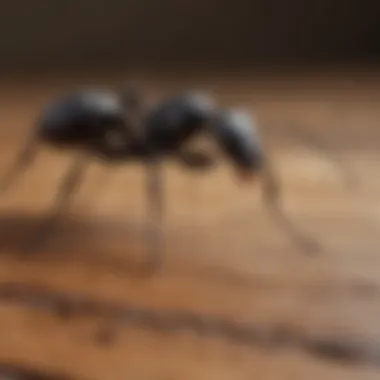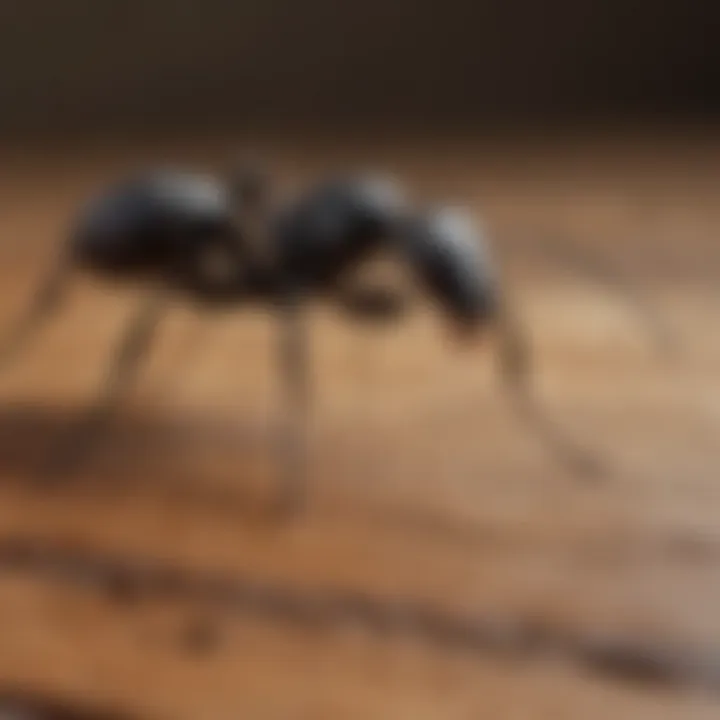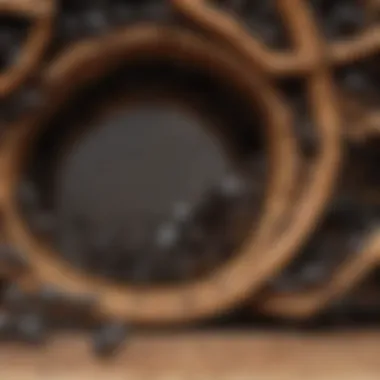Top Products to Combat Carpenter Ant Infestations


Intro
Carpenter ants can pose a significant threat to homes and structures. Understanding their behavior and biology is crucial for effective management. In this article, we will explore the best products available to control carpenter ant infestations. We will also highlight important aspects such as identification, life cycle, prevention strategies, and control methods.
Understanding the Pest
Identification
Carpenter ants are large black or bicolored ants, typically ranging from 0.25 to 1 inch in length. They have a smooth, shiny appearance without spines on their thorax. Recognizing these ants quickly is critical. Look for their nests, which often appear as sawdust piles near wood structures.
Life Cycle
Understanding the life cycle of carpenter ants is vital for effective treatment. The life cycle consists of four stages: egg, larva, pupa, and adult. The queen lays eggs that hatch into larvae. After a few weeks to months, depending on conditions, they pupate and emerge as adults. Adults can live for several years, making removal challenging.
Pest Prevention Strategies
Environment Modification
Changing the environment around your home can help reduce carpenter ant problems. Here are some key modifications:
- Reduce moisture: Fix leaks and ensure proper drainage.
- Remove wood debris: Clear any old wood piles around your property, as they can attract ants.
- Store food correctly: Keep food sealed and away from open areas to prevent attracting ants.
Physical Barriers
Creating barriers can limit the entry points for carpenter ants. Consider:
- Sealing cracks: Use caulk to seal any gaps in your home's foundation.
- Installing screens: Ensure windows and doors are properly screened to prevent entry.
Control Methods
Chemical Control
Chemical control options offer effective solutions for managing carpenter ant populations. Some recommended products include:
- Boric acid: A popular choice that disrupts the digestive system of ants.
- Insecticidal baits: Products like Terro are effective in attracting ants and eliminating them.
Biological Control
For those preferring eco-friendly methods, biological control can be a viable option. This involves using natural predators such as:
- Nematodes: Microscopic worms that can target ant larvae directly.
- Beneficial insects: Birds or other insects that naturally control ant populations.
"Knowledge of the pest's behavior and suitable treatment methods significantly improve pest control success." - Pest Management Expert
In summary, this article will provide key insights for managing carpenter ant issues. The focus will be on identifying the pests, understanding their life cycle, applying prevention strategies, and utilizing both chemical and biological control methods. Whether you are a homeowner or professional, this guide will equip you with the information necessary for effective pest management.
Understanding Carpenter Ants
Understanding carpenter ants is crucial for effective pest management. Recognizing their biology, behavior, and signs of infestation will help homeowners and property managers take timely and appropriate action. Generally, the earlier one identifies a carpenter ant problem, the easier it is to control. Infestations can lead to significant structural damage, impacting not just the home but also overall safety. Therefore, understanding these pests goes beyond academic interest; it is about ensuring a safe and sound living environment.
Biology of Carpenter Ants
Carpenter ants belong to the family Formicidae and possess a unique biological makeup. They can vary in size, typically ranging from 1/4 to 1/2 inch. Color can range from black to red or bicolored. Unlike termites, carpenter ants do not consume wood; instead, they excavate it to create nests. Their nests are often found in moist or decaying wood, though they can also inhabit foam insulation and behind walls.
The life cycle of these ants includes four stages: egg, larva, pupa, and adult. The queen is crucial for reproduction, capable of laying thousands of eggs in her lifetime. Understanding these biological details aids in selecting the right control methods, particularly those targeting their reproductive capabilities.
Behavioral Patterns
Carpenter ants display complex social structures, typically living in colonies that can consist of thousands of individuals. They are nocturnal, which means they are most active at night. Their foraging habits involve searching for food, which includes protein and sugar sources. This is essential for the overall health of the colony. They play a crucial role in the ecosystem but become problematic when they invade human structures.
One of their notable behavioral adaptations is the formation of satellite colonies. As conditions change or food sources shift, they may create new nests away from their original ones. This can complicate infestation control, as it is vital to identify all active colonies.
Signs of Infestation
Identifying signs of a carpenter ant infestation is key to early intervention. Common indicators include:
- Rustling Noises: Hearing noises within walls or ceilings, particularly at night.
- Frass: Piles of wood shavings mixed with ant droppings often found near nesting sites.
- Sawdust Piles: Actual wood debris can be a clear indication of nesting activity.
- Foraging Ants: Seeing larger ants roaming around your home in search of food.
Homeowners should monitor these signs closely, as an early response can prevent extensive property damage.
Identifying carpenter ants early can save homeowners from costly repairs.
By understanding the biology and behavior patterns of carpenter ants, as well as recognizing signs of infestation, readers can approach prevention and control with greater efficiency.
Why Carpenter Ant Control is Important
Controlling carpenter ants is crucial for various reasons. These ants, although not as deadly as termites, have significant impacts on your home and health. Understanding their behavior and the potential risks can guide effective management strategies. The need for control is not just about keeping these insects at bay but also about preserving your home’s integrity and ensuring your family’s safety.
Structural Damage
Carpenter ants cause destruction to wood structures as they excavate their nests. They prefer moist or decayed wood but can also invade sound wood if nearby damp conditions exist. Over time, their activity can weaken structural components, leading to potential safety hazards.
Consider the following issues related to structural damage:
- Nesting Behavior: Carpenter ants tunnel through wood, creating galleries and reducing its strength. Initial signs may go unnoticed.
- Cost Implications: Repairing the damage caused by these ants can be expensive. Depending on the extent, new beams or supports may be necessary.
- Long-Term Effects: If left unchecked, the damage can worsen, leading to complications that require extensive repairs. Homeowners might have to face unexpected renovations.


"Ignoring the signs of carpenter ants can lead to severe structural vulnerabilities that pose risks to inhabitants."
Health Risks
While carpenter ants do not transmit diseases directly, their presence can indicate environmental issues that may lead to health concerns. Here are some potential health risks associated with carpenter ant infestations:
- Allergies: The debris from carpenter ants' nests, including shed exoskeletons, can trigger allergies in sensitive individuals.
- Secondary Pests: Carpenter ants can attract other pests. Their nesting sites and foraging activities can create conditions favorable to mold or even invite different insects that could impact your home.
- Compromised Air Quality: In cases where nest sites are near ventilation systems, particles can circulate throughout the home, negatively affecting indoor air quality.
Effectively managing carpenter ants helps mitigate these risks, ensuring both the structural safety of a home and the health of its occupants. Ultimately, awareness and prompt action are necessary for maintaining a safe and sound living environment.
Types of Carpenter Ant Control Products
Understanding the various types of carpenter ant control products is crucial for both effective management and prevention of infestations. Each category offers distinct benefits and approaches to dealing with these pests. Selecting the right product depends on multiple factors, including the severity of the infestation, the environment, and personal preferences regarding safety and eco-friendliness. By examining these options, homeowners can make informed decisions tailored to their specific situations.
Baits
Baits are one of the most effective methods for controlling carpenter ants. They work by attracting ants to a food source that contains an insecticide. When ants consume the bait, they carry it back to their colony, effectively reducing the population. Baits are particularly useful because they target the root of the infestation rather than just eliminating visible ants.
When choosing baits, consider the active ingredients. Products containing fipronil or hydramethylnon are often effective against carpenter ants. It is important to follow the usage instructions carefully to ensure optimal results. Baits should be placed in areas where ant activity has been observed, such as near trails or nests. However, it may take some time for baits to show results, as it relies on the ants returning to feed over several days.
Insect Growth Regulators
Insect growth regulators (IGRs) offer a more specialized approach to carpenter ant control. Unlike traditional insecticides, IGRs interfere with the growth and development of insects, preventing larvae from maturing into reproductive adults. This disruption can effectively break the life cycle of carpenter ants, leading to long-term control of the infestation.
When using an IGR, it is essential to identify products that are specifically designed to target ants. Look for IGRs containing active ingredients like methoprene or pyriproxyfen. These products should be applied according to the manufacturer's instructions, usually in areas where ants are known to nest. While IGRs do not kill ants on contact, they reduce populations over time when used in conjunction with other control methods.
Sprays
Sprays provide a more immediate option for tackling carpenter ant infestations. Residual insecticide sprays can provide a barrier that deters ants from entering treated areas. Sprays are effective for both indoor and outdoor applications, targeting visible ants and creating a protective zone.
When selecting a spray, consider whether you prefer a residual or non-residual product. Residual sprays, such as those containing lambda-cyhalothrin or permetrin, remain effective for weeks or months, making them suitable for long-term control. Non-residual sprays, like pyrethrin, act quickly but may require more frequent applications. Following the application techniques outlined by the manufacturer is vital to ensure safety and effectiveness.
Traps
Traps are a non-chemical method of managing carpenter ants. These devices capture ants as they travel along foraging paths. While traps may not eliminate the entire colony, they can help monitor activity levels and reduce the number of ants in the immediate area.
There are various types of traps available, including sticky traps and baited traps. Sticky traps can be placed in high-traffic areas to capture ants. Baited traps combine the attraction of bait with a capturing mechanism to monitor and reduce the population. To optimize trap effectiveness, positioning is key. Place traps near areas where you have seen ant activity, but away from locations that are frequently disturbed by household activities.
Properly utilizing these various products can provide a comprehensive approach to controlling carpenter ant infestations, balancing immediate action with long-term strategies.
Best Baits for Carpenter Ants
In managing carpenter ant infestations, selecting appropriate baits is crucial. Baits serve as an effective method to lure ants, enabling more direct control of the colony. Unlike sprays that may kill ants on contact, baits allow for consumption over time, facilitating the transfer of poisons through the nest. This method not only reduces the overall population but also addresses the queen, effectively diminishing future infestations. Homeowners should consider several factors when choosing baits, including the specific active ingredients and how to use them correctly.
Active Ingredients
The effectiveness of bait products often heavily relies on their active ingredients. Common components include fipronil, hydramethylnon, and boric acid. Each ingredient has unique characteristics.
- Fipronil: This is a slow-acting insecticide. It allows for the bait to be taken back to the colony, leading to a more extensive impact.
- Hydramethylnon: This ingredient works effectively on a sugar-based bait. Many carpenter ants are attracted to this, making it an excellent choice.
- Boric Acid: Less toxic than synthetic chemicals, boric acid also aids in long-term population control. Ants consume it, which disrupts their digestive system.
Choosing the right active ingredient can make a significant difference in controlling carpenter ants effectively.
Usage Instructions
Correct usage of baits is essential for achieving the desired results. Here are some methods to ensure effectiveness:
- Locate Ant Trails: Observe ant movement. Baits should be placed directly on their trails to maximize exposure.
- Use Multiple Bait Stations: Set up several bait stations in various locations. This increases the chances of ants detecting the bait.
- Regularly Check and Replace Baits: Ants may consume the bait quickly. Regular monitoring helps to ensure that the bait remains effective and continues to attract ants.
- Keep Clean: Remove other food sources in the area. This will encourage ants to focus on the bait rather than seeking alternative food.
By following these practices, homeowners can significantly enhance the efficacy of the bait products against carpenter ants.
Effective Sprays for Carpenter Ants
When dealing with carpenter ants, effective sprays play a crucial role in controlling their populations. Sprays can target both visible ants and those hidden in nests. Their versatility makes them essential for both immediate and long-term solutions in pest management. By understanding the differences between types of sprays, homeowners can choose the best product for their situations, ensuring more effective control and minimizing damage to their property. This section delves into two main categories of sprays: residual and non-residual, as well as the techniques for applying them correctly.
Residual and Non-Residual Sprays
Sprays for carpenter ants can be classified into two categories: residual and non-residual.
- Residual Sprays have lasting effects. Once applied, they continue to kill ants that come into contact with the treated surfaces for weeks or even months. This lasting potency can be beneficial for homeowners looking to establish a long-term barrier against carpenter ants. Products like Spectracide Pro and Ortho Home Defense are well-known examples due to their efficiency. However, it is important to consider that as these sprays persist, they may harm beneficial insects and the environment if not used wisely.
- Non-Residual Sprays, on the other hand, are best used for immediate results. They act quickly, killing ants upon contact without leaving a long-lasting residue. This can be ideal for targeted applications in specific areas of the home, where immediate action is necessary. They are often made from safer chemicals, making them an option for households with pets or children.
Every type of spray has its pros and cons. Homeowners should evaluate their specific needs and consider environmental impact when choosing a spray.
Application Techniques
The effectiveness of any spray depends significantly on the application techniques used. Here are some key points to consider when applying sprays for carpenter ants:
- Read Instructions: Always check the label for specific directions on application. Each product is different and instructions may vary based on the situation.
- Choose Right Time: Early morning or late evening is preferable as ants are more active during these times, increasing the chances of exposure to the spray.
- Focus on Entry Points: Identify where carpenter ants enter the building. Apply sprays to these areas, including doorways, windows, and cracks.
- Use Proper Equipment: A sprayer allows for even distribution. Ensure that the nozzle is adjustable for tailored application.
- Reapply as Needed: Depending on the product, regular reapplications may be necessary. Specifc residue products might need to be reapplied after rain or cleaning activities to maintain effectiveness.
- Avoid Over-Spraying: Target specific areas instead of extensive spraying, as this reduces the risk of unwanted chemical exposure to pets and children.
By following these application techniques, homeowners can enhance the effectiveness of the sprays and keep carpenter ant populations at bay. Effective use of sprays will ultimately lead to a better handling of carpenter ants, providing peace of mind and a safer environment.
Important: Regular checks and monitoring after spray application are essential to confirm whether the control measures have been successful or if further action is needed.
Pros and Cons of Insect Growth Regulators
Insect growth regulators (IGRs) are an important tool in the fight against carpenter ants. Understanding their advantages and disadvantages will help homeowners make informed decisions about pest control. IGRs work by disrupting the normal development of insects, preventing them from maturing to reproductive adults. This targeted approach is less harmful to non-target species and focuses on breaking the life cycle of the pests.
Mechanism of Action


IGRs operate through different mechanisms. They can mimic natural hormones in insects, sabotaging their growth and reproductive processes. For instance, these regulators may inhibit the production of hormones vital for molting. As a result, the ants cannot grow properly, leading to a decline in their population over time.
- Types of IGRs:
- Chitin Synthesis Inhibitors: Prevents the formation of exoskeletons.
- Hormone Mimics: Triggers unnatural growth cycles.
Considerations regarding their use include the importance of proper application. Incorrect application can lead to limited effectiveness, as ants not in the targeted life stage may not be affected.
Effective IGRs can take time to show results, as they disrupt life cycles rather than kill ants outright.
Effectiveness
The effectiveness of IGRs varies based on several factors, including the specific formulation used and how it is applied. Generally, IGRs have proven successful in controlling carpenter ant populations by ensuring that fewer mature ants can reproduce. However, they should not be relied upon as a standalone solution.
- Factors affecting effectiveness:
- Application Technique: Spray, baits, or mixed use can influence results.
- Environmental Conditions: Humidity and temperature can affect the longevity of IGRs.
- Resistance Development: Over time, some ant populations may develop resistance, making it crucial to rotate pest control strategies.
In summary, while IGRs present clear benefits, including a reduced impact on the surrounding environment, their drawbacks warrant careful consideration. Homeowners should complement IGR use with other methods for a more comprehensive approach to manage carpenter ant infestations.
Using Traps Effectively
Using traps effectively is a crucial component of managing carpenter ant infestations. Traps offer a method of control that can reduce populations over time. They work without the use of chemicals, appealing to those seeking eco-friendly solutions. This section will examine the types of traps available and how to optimally place them to increase effectiveness and catch rates.
Types of Traps
There are several types of traps utilized for controlling carpenter ants. Each type offers unique benefits and can be strategically chosen based on the specific needs of the environment. The common types include:
- Boric Acid Traps: These traps contain a bait that attracts ants. When consumed, the boric acid inside effectively disrupts their digestive system.
- Pheromone Traps: These traps use synthetic scents to lure carpenter ants. The pheromones mimic the natural scents ants use to communicate, making them effective for capturing worker ants.
- Glue Traps: Simple in design, glue traps utilize a sticky surface. Carpenter ants become stuck when they walk over the traps, allowing for easy monitoring of activity levels.
Selecting the right type of trap ensures that the approach aligns with the severity of the infestation. Each trap has its advantages. Boric acid traps can kill ants and reduce the population over time, while glue traps are effective in monitoring activity.
Placement Strategies
Effective placement of traps is essential to maximize their function. It requires understanding ant behavior and their movement patterns. Here are some important placement strategies:
- Identify Trails: Before placing traps, observe where carpenter ants commonly travel. This can be near food sources or structural defects in the home.
- Corners and Entry Points: Place traps in corners of rooms and near potential entry points, such as doors and windows. These areas typically see more ant traffic.
- Near Nesting Sites: If the nest has been identified, traps should be placed nearby to intercept scouts and workers returning to the nest.
- Regular Checks: After traps are set, regular monitoring is necessary. This will help assess the success of trapping efforts and when to replace baits or traps.
Using traps can significantly help in reducing the carpenter ant population while allowing for strategic management without chemicals.
By understanding the types of traps and employing effective placement strategies, homeowners can take significant steps in controlling carpenter ants. This approach enhances the overall pest management strategy, ensuring that infestations are handled effectively without overwhelming reliance on chemical solutions.
Eco-Friendly Pest Control Options
Controlling carpenter ants in a sustainable manner is increasingly recognized as essential. Homeowners are more concerned about the impact of pesticides on their environment and health. Eco-friendly pest control options provide effective solutions while minimizing harmful effects on nature and non-target organisms. These methods not only address the problem of carpenter ants but also align with a growing societal trend toward sustainability.
Adopting eco-friendly strategies can add long-term benefits to pest management, especially for those with children or pets in the home. Many natural products or methods are effective at repelling or controlling carpenter ants without resorting to chemical pesticides.
Natural Repellents
Natural repellents are substances derived from plants or other natural sources that deter pests, including carpenter ants. Some well-known ingredients include peppermint oil, diatomaceous earth, and vinegar. Here is a closer look at several popular natural alternatives:
- Peppermint Oil: Its strong aroma can interfere with the ants' chemical communication, making it hard for them to navigate.
- Diatomaceous Earth: This powdery substance is effective when ants come into contact with it. It damages their exoskeleton and leads to dehydration.
- Vinegar: Spraying a mixture of vinegar and water around entry points can disrupt ant trails, which they use to communicate with each other.
Using these natural options can provide a dual benefit. They can be a proactive solution to deter ants while also leaving behind pleasant scents or a clean feeling in the home.
Biological Control
Biological control refers to the use of natural predators or pathogens to manage pest populations. This method focuses on long-term sustainability. For carpenter ants, using organisms like nematodes or introducing certain predatory insects can be effective.
- Nematodes: These microscopic worms are known to attack insects such as carpenter ants. They enter the ant's body and release bacteria that kill the host.
- Ant-eating beetles: Introducing predatory beetles can keep the carpenter ant population under control. These beetles can thrive in many environments, making them a versatile choice.
DIY Methods for Carpenter Ant Control
The topic of DIY methods for carpenter ant control holds significant relevance in pest management. Many homeowners prefer do-it-yourself approaches due to cost and accessibility. These methods empower individuals to take control of their living spaces. Understanding how to effectively manage carpenter ant infestations with DIY techniques can lead to a more sustainable and proactive approach.
Homemade Bait Solutions
Homemade bait solutions provide an effective way to target carpenter ants directly. The primary goal is to attract ants and deliver a slow-acting poison to the colony. Using commonly available kitchen ingredients can be both economical and efficient.
A popular mix involves boric acid and sugar. The sugar acts as a lure, while boric acid poisons the ants. You can create your bait by combining:
- 1 cup of sugar
- 1 cup of water
- 1 tablespoon of boric acid
Mix the ingredients until the sugar dissolves completely. Place the bait in shallow containers and set them near known ant trails. Adjust the ratio of sugar and boric acid according to your observation of ant activity. It's crucial to monitor and refresh bait regularly for optimal effectiveness.
Preventive Measures
Taking preventive measures is essential in reducing the risk of carpenter ant infestations. These methods focus on minimizing attractants and potential nesting sites around the home. Proper maintenance and vigilance can discourage ants from establishing their colony.
Here are some effective strategies:
- Seal Entry Points: Inspect your home for any gaps or cracks. Caulk gaps around windows, doors, and utility pipes. Ensuring seals are tight prevents ants from entering.
- Eliminate Moisture Sources: Carpenter ants are attracted to moisture. Address plumbing leaks and ensure gutters are functioning well. Keep basements dry and ventilated to reduce humidity levels.
- Store Food Properly: Ants seek food sources. Store sugar, syrup, and pet food in airtight containers. Clean up spills immediately.
- Trim Vegetation: Keep trees and shrubs trimmed, especially those near your home. This limits access to the roof and walls.
By actively applying these preventive measures, you can significantly reduce the risk of carpenter ant infestations and maintain a healthier home environment.


"Proactive prevention is often more effective than reactive measures when dealing with pests."
Implementing a combination of homemade bait solutions and preventive measures creates a more fortified defense against carpenter ants. These DIY methods not only aid in control but also offer homeowners a sense of empowerment over their living conditions.
Professional Pest Control Services
Engaging professional pest control services can be a crucial element in effectively managing carpenter ant infestations. While some homeowners may opt for DIY treatments, the complexity and potential for structural damage from carpenter ants often necessitate expert intervention. Professionals have the tools, knowledge, and experience to deal with more severe infestations and can provide a more thorough inspection of the premises. They can identify specific species, their entry points, and nesting sites, which can be difficult for untrained individuals.
Furthermore, pest control services offer tailored solutions that consider the unique needs of each situation. They typically employ a combination of products and techniques, which may include baiting, pesticide applications, and structural advice. Understanding the behavior of carpenter ants allows professionals to develop a strategy that not only addresses the current infestation but also mitigates future risks.
When to Call Professionals
Knowing when to call in professionals is essential for effective carpenter ant control. Signs indicating the need for expert assistance often include:
- Visible colonies: Discovering multiple ants during an inspection.
- Structural damage: Evidence of tunneling in wood or weakened structures.
- Previous unsuccessful attempts: Ineffectiveness of DIY solutions.
- Large infestations: Situations that appear overwhelming, especially in expansive homes.
- Health concerns: If there are concerns related to allergies from ant droppings or other health risks.
When these signs are present, it is advisable to consult professionals. Delaying action can lead to increased damage and costlier remedies.
What to Expect from Services
When hiring pest control professionals to address a carpenter ant issue, customers can expect a systematic approach to treatment. Key expectations include:
- Initial Inspection: Thorough assessment to identify infestations and nests.
- Customized Treatment Plan: A strategy tailored to the specific infestation and environmental conditions.
- Safe Product use: Professionals are trained to apply pesticides safely and efficiently, minimizing harm to pets and family.
- Follow-Up: Continuous monitoring and follow-up visits may be necessary to ensure that the problem is resolved completely.
- Prevention Advice: Guidance on how to prevent future infestations, such as sealing entry points and reducing moisture sources in the home.
"A key part of pest control is not just to eliminate the pests but to understand their behavior and prevent them from returning."
Monitoring and Follow-Up
Monitoring and follow-up are critical components in the effective management of carpenter ant infestations. Their significance cannot be overstated, as simply applying treatments without subsequent observation can lead to unresolved issues. By closely monitoring the situation, homeowners can ensure that the applied solutions have been effective and can promptly address any new signs of activity.
One primary advantage of continuous monitoring is the early detection of any reinfestation. Carpenter ants can easily return if previous nests or food sources are not adequately dealt with. By maintaining a vigilant watch, homeowners can catch new activity while it is still manageable. This involves regularly checking the areas known for previous infestations and being attentive to any changes in ant behavior, such as increased activity or new trails.
In addition, monitoring can help evaluate the effectiveness of the control measures being used. Different products and methods may vary in effectiveness based on the specific circumstances of a home or the characteristics of the infestation. By documenting findings and changes in activity, homeowners can make informed decisions about which strategies are proving successful and which ones might need adjustment or replacement.
“Effective monitoring prevents the unnecessary spread of infestations and keeps control methods efficient.”
Carpenter ants can be elusive, necessitating a systematic approach to checking both indoors and outdoors. It is essential to look for signs such as wood shavings, frass, and actual ant activity to gain a clear understanding of the extent of the problem. This also allows for tailoring follow-up actions based on real-time information.
Ultimately, the purpose of monitoring and follow-up is to shift from a reactive to a proactive approach in pest management. Homeowners can create a more robust infrastructure for preventing future infestations by establishing targeted monitoring strategies and adapting methods of control to ongoing observations.
Inspecting for Activity
Inspecting for activity involves a thorough examination of the home for signs of carpenter ants. Regular inspections should focus on known hotspots like wooden structures, kitchens, and areas with moisture problems, as these are attractive to ants.
A detailed inspection should include:
- Looking for trails: Look for ant trails, as they follow scent markers left by other ants.
- Checking for frass: Frass, the wood shavings and debris left behind, is a clear indicator of carpenter ant activity.
- Monitoring wood damage: Check wood that seems soft or has holes, which could indicate nesting.
- Surveying high-moisture areas: Carpenter ants are particularly drawn to areas with leaks or high humidity.
After these checks, it is advisable to document findings to compare later.
Continuous Prevention Strategies
Continuous prevention strategies play a vital role in deterring carpenter ants from returning. Once an infestation is inspected and controlled, maintaining a pest-proof environment is essential. Here are several effective strategies:
- Sealing entry points: Close any gaps in walls, doors, and windows to limit access.
- Reducing moisture: Ensure that plumbing is intact and fix any leaks, as carpenter ants thrive in damp conditions.
- Trimming vegetation: Keep trees and shrubs trimmed back from the home’s exterior so ants cannot easily transition from landscaping to the house.
- Using bait stations: Strategically placing bait stations in high-traffic areas may provide ongoing control.
- Regularly scheduled inspections: Establish a routine for checking potential problem areas to ensure any new activity is detected promptly.
By making preventive measures a regular part of home maintenance, homeowners can significantly reduce the risk of future carpenter ant problems.
Case Studies of Effective Carpenter Ant Control
Understanding how various methods operate in real-world scenarios helps in recognizing their efficacy. Case studies of effective carpenter ant control play a crucial role in providing practical insights based on tangible experiences. By evaluating a diverse array of situations, one can glean lessons that may not be apparent through theoretical approaches. This section aims to present both residential and commercial experiences, drawing valuable conclusions from these examples.
Residential Experiences
In many homes, carpenter ants often invade unnoticed. Homeowners may initially dismiss a few sightings as ephemeral nuisances, only to realize later the extent of an infestation. One notable case involved a suburban homeowner who discovered signs of carpenter ant activity in a wooden siding.
The homeowner opted for a combination of baiting and residual spray. He placed bait stations in strategic locations, particularly near areas where ant trails were noted. Over several weeks, the homeowner observed a significant reduction in activity.
Moreover, it was essential to seal entry points around the house after applying control methods to prevent a re-invasion. Emphasizing preventive measures post-treatment proved beneficial. Many homeowners share similar stories, indicating that following a systematic approach helps mitigate risks associated with these pests.
Commercial Solutions
Businesses face unique challenges with carpenter ants. A case study involving a small café illustrated how critical timely intervention is. The café, housed in an older building, experienced an increase in ant sightings in the storage area. The owner promptly contacted a pest control service.
The professionals conducted a thorough inspection, discovering a nest within the walls. Utilizing insect growth regulators and targeted sprays effectively removed the infestation while allowing the café to remain operational. Regular follow-ups ensured that any residual activity was quickly addressed.
Both cases show that awareness and timely action are critical in dealing with carpenter ants. Identifying the issue ahead of time leads to more effective results, whether in residential spaces or within commercial environments. By analyzing these experiences, readers can better appreciate the challenges posed by carpenter ants and the importance of implementing appropriate control measures.
Finale and Recommendations
In summary, controlling carpenter ants is a significant undertaking that requires informed decisions and the right tools. This article has explored a range of products and methods, enabling readers to develop a thorough understanding of how best to combat these pests. The importance of selecting the right products cannot be overstated. The different methods, such as baits, sprays, and traps, each offer unique benefits and challenges.
Effective Product Combinations
Combining different pest control methods often yields the best results. Using baits alongside sprays can enhance the overall effectiveness. For instance, while the baits attract and kill ants, sprays can eliminate their immediate presence in the surroundings. Effective combinations can look like the following:
- Bait and Spray: Use a bait with a slow-acting insecticide, such as boric acid, to ensure ants carry it back to their colony.
- Spray and Traps: Apply a residual spray in areas known for ant activity and use traps to capture any remaining ants.
- Traps and DIY Solutions: Implement traps alongside homemade baits made from sugar and water to entice ants.
These combinations not only work effectively but also minimize potential dangers associated with over-reliance on strong chemical solutions.
Future Trends in Ant Control
As technology advances, the future of pest control may focus on more sustainable and eco-friendly solutions. Integrated Pest Management (IPM) strategies will likely gain traction, allowing homeowners to combine cultural, mechanical, and biological tactics. Furthermore, research into natural repellents, which carry lesser risks to health and the environment, will continue to evolve. Organic solutions such as diatomaceous earth and essential oils may see a rise in use due to increasing consumer awareness of health and ecological impacts.







